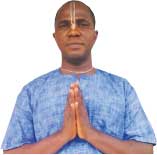An allegory from the Srimad-Bhagavatam sheds light on the mind/body connection.
Is there a conscious self that is distinct from the physical mechanism of the body? Is there a mind distinct from the brain? Those who answer yes to such questions are called dualists, and they are rare in contemporary science and philosophy.
Dualistic solutions to the mind/body problem are perhaps hampered by, among other things, inadequate analogies and allegories on the topic in Western thought. Whether we turn to Plato’s cave, to the formulations of Descartes, or to the proverbial little green man in the brain, there is apparently not enough substance to inspire the modern researcher of consciousness to seriously consider dualism. But if we turn to chapters 25-29 of Canto Four in the Bhagavata Purana, or Srimad-Bhagavatam, a Sanskrit text from India, we’ll find the elaborate allegory of the City of Nine Gates. The sophistication of this allegory challenges modern researchers to take a second look at dualism.
The central character in the allegory is a king named Puranjana. The Sanskrit word puran-jana means “one who enjoys in a body”. So the king’s name hints at soul/body dualism. King Puranjana originally existed as a spirit soul in a purely spiritual realm in relationship with a supreme conscious being, God.
Materialists may oppose the introduction of this transcendental realm, which exists outside the material universe knowable by science. But even the materialist cosmology of modern science incorporates a “transcendental” realm, that is to say, a realm that exists beyond the universe knowable by science, and from which that universe emerged at the time of the Big Bang. This transcendental reality, existing beyond time, space and matter, is called the quantum mechanical vacuum and is pictured as a pure energy field in which particles appear and instantly disappear. From this sea of virtual particles, some expand and continue to exist. According to many cosmologists, our universe is one such expansion.
So, both the Bhagavata Purana and the Big Bang cosmology of modern science point to an eternal transcendental existence from which our universe of matter, with its features of time and space, arises. Now, which version of ultimate reality better explains the variegated reality of our experience? Modern cosmologists and other theorists have a great deal of difficulty in coaxing enough variety from the rather smooth and featureless universe that, according to theory, expands from the quantum mechanical vacuum. The origin of consciousness also poses a difficult problem. In light of this, an ultimate reality that is itself conscious and variegated might offer a solution.
Having departed from the spiritual world, by misuse of independence, King Puranjana journeys through the material world, accompanied by Avijnata Sakha (“the unknown friend”). The Unknown Friend corresponds to the Supersoul expansion of God. When Puranjana leaves God and the spiritual world, his memory of them becomes covered. But unknown to Puranjana, God accompanies him on his journey through the material world. According to the Bhagavata Purana, God accompanies all spirit souls in the material world as their Unknown Friend, who observes and sanctions their activities.
In the Western world, mind/brain dualism is identified with French philosopher, Rene Descartes, who posited the existence of (1) matter extended in space and (2) mind existing outside space. Cartesian dualism is characterised by an interaction between mind and matter, but explaining how this interaction takes place has proved problematic for advocates of the Cartesian model. For example, how are impressions transmitted from the realm of matter to the completely different realm of mind? Descartes thought the connection between mind and matter occurred in the pineal gland in the brain, an answer most scientists today reject.
According to the Bhagavata Purana, both matter and the souls in the material world are energies of God, and as such both have a single spiritual source. The philosophy of the Bhagavata Purana is thus both dualist and monist simultaneously. The interactions of matter and the soul in the material world are mediated by the Supersoul, who exists inside each material atom and also accompanies each spirit soul. By the arrangement of the Supersoul, impressions of material experience can be channelled to the soul. How this takes place is the subject of the allegory of Puranjana.
Having left the spiritual world, Puranjana, accompanied by Avijnata Sakha (the Supersoul), wanders through the material world. He wants to find a suitable place to enjoy himself. In other words, he searches for a suitable kind of body to inhabit. He tries many kinds of bodies on many planets.
Here we note that each specie of life consists of a soul inhabiting a particular kind of body. In this respect, the Bhagavata Purana account differs from that of Descartes, who held that only humans have souls. For Descartes, animals were simply automatons. If one concedes that animals, with all their signs of life and consciousness, are simply automatons, then why not human beings as well? TheBhagavata Purana model avoids this weakness of Descartes’s system.
The attractive city
Eventually, Puranjana comes to a place called Nava Dvara Pura, the City of Nine Gates. He finds it quite attractive. The City of Nine Gates represents the male human body, with its nine openings: two eyes, two nostrils, two ears, the mouth, the anus and the genital opening. As Puranjana wanders through the gardens of the city, he encounters an extremely beautiful woman. Puranjana is attracted to her, and she is attracted to him. She becomes his queen.
Puranjana, as we have seen, represents the conscious self. The beautiful woman represents buddhi (intelligence). According to the philosophy of the Bhagavata Purana, intelligence is a subtle material energy with discriminatory capabilities like those manifested by artificial intelligence machines. The attraction between King Puranjana and the queen (between the conscious self and the intelligence) is the root of embodied consciousness. The king, it should be noted, has distinct conscious selfhood, with non-material sensory capability, but this capability becomes dormant when he begins his relationship with the queen.
The queen (the subtle material element called intelligence) allows Puranjana (the conscious self) to enjoy the City of Nine Gates (the gross physical body). Employing a computer analogy, we might say Puranjana represents the user, the City of Nine Gates the computer hardware, and the queen the software that allows the user to interface with the hardware and use it for practical purposes.
The queen is not alone, however, but is accompanied by 11 bodyguards and a serpent with five heads. The bodyguards comprise the mind and the 10 senses. The 10 senses are made up of five knowledge-acquiring senses and five working senses. The five knowledge-acquiring senses are the senses of sight, smell, taste, hearing and touch. The five working senses are those of walking, grasping, speaking, reproduction and evacuation. All 10 senses are grouped around the mind and are considered servants of the mind. Each of these servants has hundreds of wives. The wives represent desires for material experience, and the senses act under their pressure.












